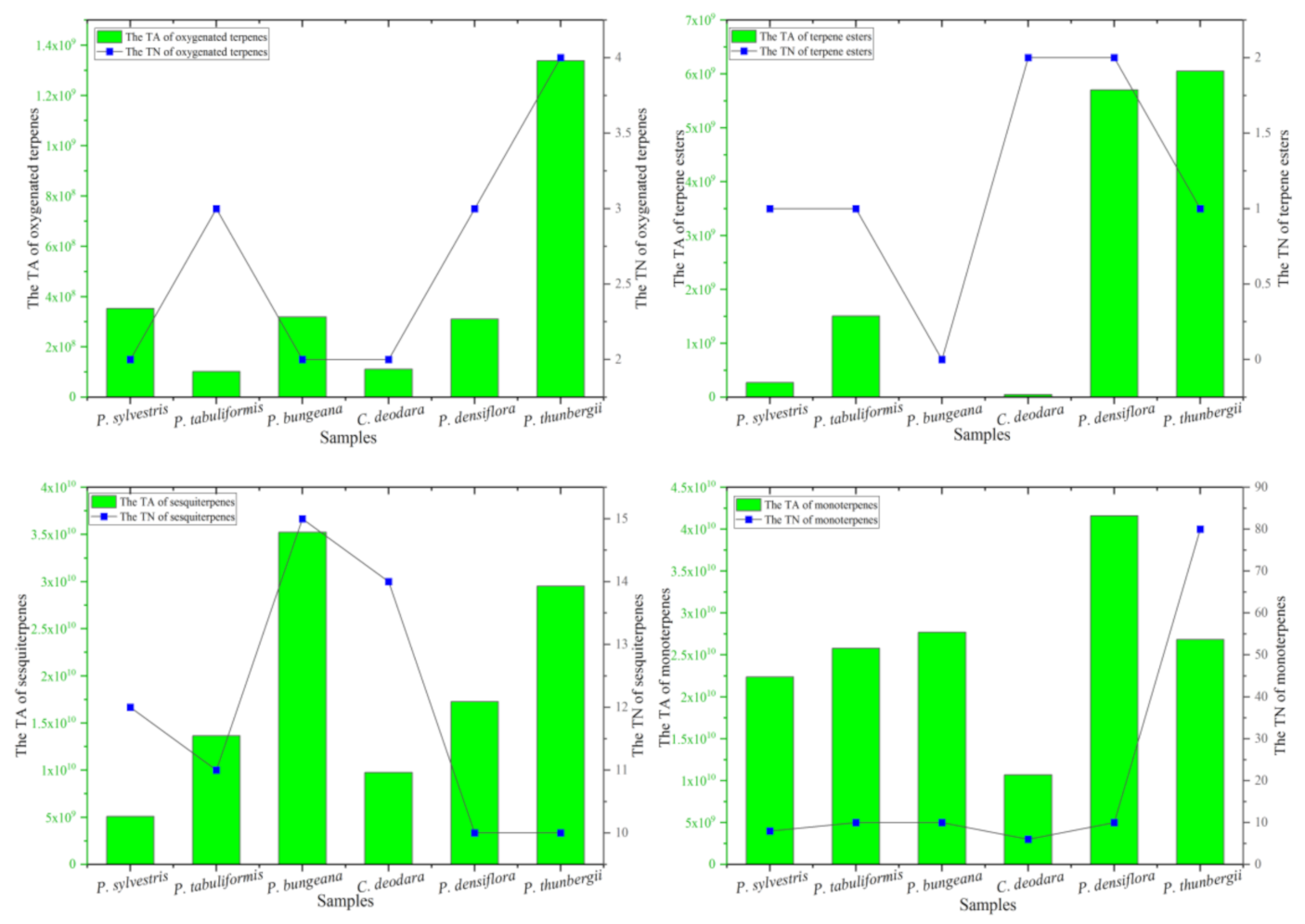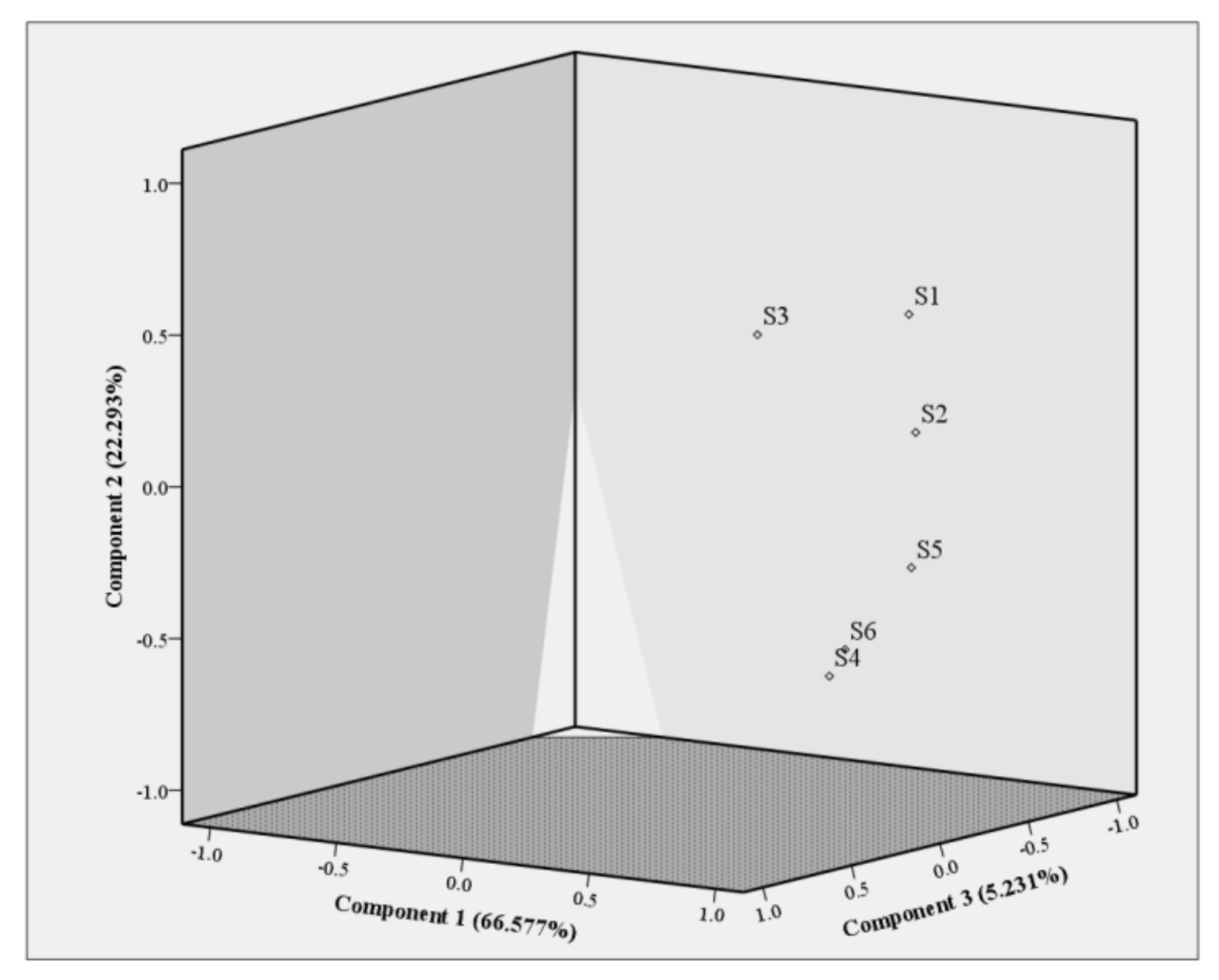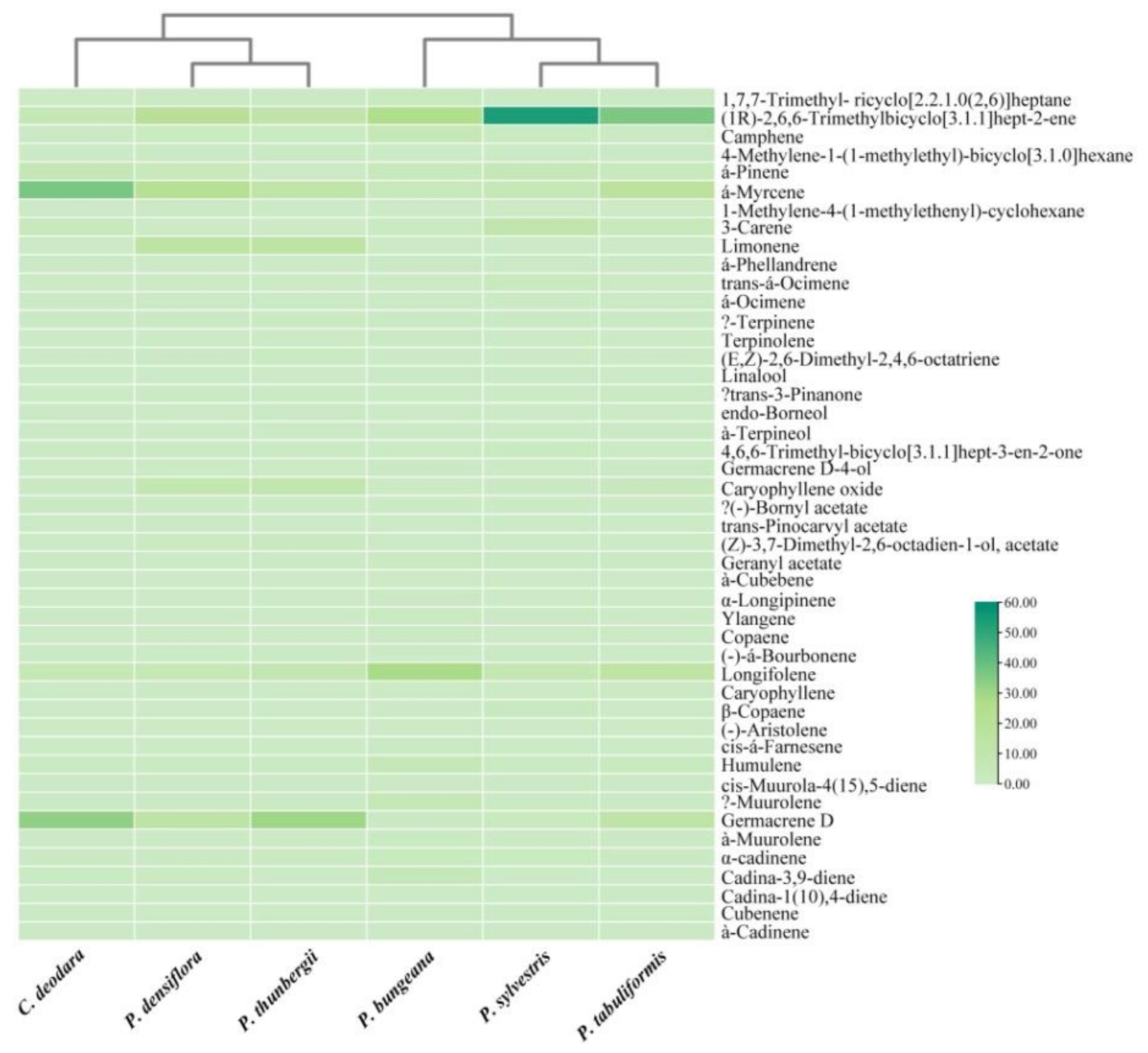Comparative Analysis of Volatile Terpenes and Terpenoids in the Leaves of Pinus Species—A Potentially Abundant Renewable Resource
Abstract
1. Introduction
2. Results and Discussion
2.1. Identification and Comparison of Volatile Terpenes and Terpenoids
2.2. Comparison of Volatile Terpenes and Terpenoids
2.3. PCA of SPME-GC-MS
2.4. CA of HS-SPME-GC-MS
3. Materials and Methods
3.1. Plant Material and Reagents
3.2. Instruments and Equipments
3.3. Test Method
3.3.1. Sample Preparation and Extraction Process for HS-SPME
3.3.2. GC/MS Analysis Conditions
3.3.3. Statistical Analysis
4. Conclusions
Author Contributions
Funding
Institutional Review Board Statement
Informed Consent Statement
Data Availability Statement
Conflicts of Interest
Sample Availability
References
- Hizume, M.; Shibata, F.; Matsusaki, Y.; Garajova, Z. Chromosome identification and comparative karyotypic analyses of four Pinus species. Theor. Appl. Genet. 2002, 105, 491–497. [Google Scholar] [CrossRef]
- Kim, H.; Lee, B.; Yun, K.W. Comparison of chemical composition and antimicrobial activity of essential oils from three Pinus species. Ind. Crop. Prod. 2013, 44, 323–329. [Google Scholar] [CrossRef]
- Jung, K.H.; Yoo, S.K.; Moon, S.K.; Lee, U.S. Furfural from pine needle extract inhibits the growth of a plant pathogenic fungus, Alternaria mali. Mycobiology 2007, 35, 39–43. [Google Scholar] [CrossRef] [PubMed]
- Hwang, J.S.; Bae, J.J.; Choo, Y.S. Effects of an aqueous red pine (Pinus densiflora) needle extract on growth and physiological characteristics of soybean (Glycine max). J. Ecol. Field Biol. 2011, 34, 279–286. [Google Scholar] [CrossRef][Green Version]
- Zhang, Y.D.; Xin, C.; Cheng, C.L.; Wang, Z.Y. Antitumor activity of nanoemulsion based on essential oil of Pinus koraiensis pinecones in MGC-803 tumor-bearing nude mice. Arab. J. Chem. 2020, 13, 8226–8238. [Google Scholar] [CrossRef]
- Wang, C.; He, L.; Yan, M.; Zheng, G.Y.; Liu, X.Y. Effects of polyprenols from pine needles of Pinus massoniana on ameliorating cognitive impairment in ad-galactose-induced mouse model. Age 2014, 36, 9676. [Google Scholar] [CrossRef] [PubMed][Green Version]
- He, J. Bioactivity-guided fractionation of pine needle reveals catechin as an anti-hypertension agent via inhibiting angiotensin-converting enzyme. Sci. Rep. 2017, 7, 8867. [Google Scholar] [CrossRef]
- Kim, T.; Song, B.; Cho, K.S.; Lee, I.S. Therapeutic potential of volatile terpenes and terpenoids from forests for inflammatory diseases. Int. J. Mol. Sci. 2020, 21, 2187. [Google Scholar] [CrossRef]
- Unsicker, S.B.; Kunert, G.; Gershenzon, J. Protective perfumes: The role of vegetative volatiles in plant defense against herbivores. Curr. Opin. Plant Biol. 2009, 12, 479–485. [Google Scholar] [CrossRef]
- Heil, M. Indirect defence via tritrophic interactions. N. Phytol. 2008, 178, 41–61. [Google Scholar] [CrossRef]
- Goncalves, E.; Figueiredo, A.C.; Barroso, J.G.; Henriques, J.; Sousa, E.; Bonifacio, L. Effect of Monochamus galloprovincialis feeding on Pinus pinaster and Pinus pinea, oleoresin and insect volatiles. Phytochemistry 2020, 169, 112159. [Google Scholar] [CrossRef]
- Guimarães, A.G.; Serafini, M.R.; Quintans-Júnior, L.J. Terpenes and derivatives as a new perspective for pain treatment: A patent review. Expert Opin. Ther. Pat. 2014, 24, 243–265. [Google Scholar] [CrossRef]
- Dubey, V.S.; Bhalla, R.; Luthra, R. An overview of the non-mevalonate pathway for terpenoid biosynthesis in plants. J. Biosci. 2003, 28, 637–646. [Google Scholar] [CrossRef] [PubMed]
- Cho, K.S.; Lim, Y.R.; Lee, K.; Lee, J.; Lee, J.H.; Lee, I.S. Terpenes from forests and human health. Toxicol. Res. 2017, 33, 97–106. [Google Scholar] [CrossRef]
- Mitic, Z.S.; Jovanovic, S.C.; Zlatkovic, B.K.; Nikolic, B.M.; Stojanovic, G.S.; Marin, P.D. Needle terpenes as chemotaxonomic markers in Pinus: Subsections Pinus and Pinaster. Chem. Biodivers. 2017, 14, e1600453. [Google Scholar] [CrossRef] [PubMed]
- Zhou, Z.Y.; Xian, J.C.; Wei, W.K.; Xu, C.; Yang, J.; Zhan, R.T.; Ma, D.M. Volatile metabolic profiling and functional characterization of four terpene synthases reveal terpenoid diversity in different tissues of Chrysanthemum indicum L. Phytochemistry 2021, 185, 112687. [Google Scholar] [CrossRef] [PubMed]
- Sayout, A.; Ouarhach, A.; Rabie, R.; Dilagui, I.; Soraa, N.; Romane, A. Evaluation of antibacterial activity of Lavandulapedunculata subsp. atlantica (Braun-Blanq.) Romo essential oil and selected terpenoids against resistant bacteria strains-structure-activity relationships. Chem. Biodivers. 2020, 17, e1900496. [Google Scholar] [CrossRef] [PubMed]
- Huang, M.; Lu, J.J.; Huang, M.Q.; Bao, J.L.; Chen, X.P.; Wang, Y.T. Terpenoids: Natural products for cancer therapy. Expert Opin. Investig. Drugs 2012, 21, 1801–1818. [Google Scholar] [CrossRef] [PubMed]
- Zhu, W.; Liu, X.; Wang, Y.; Tong, Y.; Hu, Y. Discovery of a novel series of α-terpineol derivatives as promising anti-asthmatic agents: Their design, synthesis, and biological evaluation. Eur. J. Med. Chem. 2018, 143, 419–425. [Google Scholar] [CrossRef]
- Remigius, C.; Katharina, M. Variability of volatiles in Pinus cembra L. within and between trees from a stand in the Salzburg Alps (Austria) as assessed by essential oil and SPME analysis. Genet. Resour. Crop. Evol. 2021, 68, 567–579. [Google Scholar]
- Gulden, D.; Eyup, B. Chemical composition of essential oil of Pinus nigra subsp pallasiana (Pinaceae) twigs, from different regions of Turkey. J. Essent. Oil Bear. Plants 2018, 21, 511–519. [Google Scholar]
- Zielinska-Blajet, M.; Feder-Kubis, J. Monoterpenes and their derivatives-recent development in biological and medical applications. Int. J. Mol. Sci. 2020, 21, 7078. [Google Scholar] [CrossRef]
- Orhan, I.; Küpeli, E.; Aslan, M.; Kartal, M.; Yesilada, E. Bioassay-guided evaluation of anti-inflammatory and antinociceptive activities of pistachio, Pistacia vera L. J. Ethnopharmacol. 2006, 105, 235–240. [Google Scholar] [CrossRef] [PubMed]
- Kang, E.; Lee, D.H.; Jung, Y.; Shin, S.Y.; Koh, D.; Lee, Y.H. α-Pinene inhibits tumor invasion through downregulation of nuclear factor (NF)-κB-regulated matrix metalloproteinase-9 gene expression in MDA-MB-231 human breast cancer cells. Appl. Biol. Chem. 2016, 59, 511–516. [Google Scholar] [CrossRef]
- Lu, Z.G.; Wang, J.Z.; Qu, L.N.; Kan, G.H.; Zhang, T.L.; Shen, J.; Li, Y.; Yang, J.; Niu, Y.W.; Xiao, Z.B.; et al. Reactive mesoporous silica nanoparticles loaded with limonene for improving physical and mental health of mice at simulated microgravity condition. Bioact. Mater. 2020, 5, 1127–1137. [Google Scholar] [CrossRef]
- Ilardi, V.; Badalamenti, N.; Bruno, M. Chemical composition of the essential oil from different vegetative parts of Foeniculum vulgare subsp. piperitum (Ucria) coutinho (Umbelliferae) growing wild in Sicily. Nat. Prod. Res. 2020, 1–11. [Google Scholar] [CrossRef]
- Abdullahi, A.; Ahmad, K.; Ismail, I.S.; Asib, N.; Ahmed, O.H.; Abubakar, A.I.; Siddiqui, Y.; Ismail, M.R. Potential of using ginger essential oils-based nanotechnology to control tropical plant diseases. Plant Pathol. J. 2020, 36, 515–535. [Google Scholar] [CrossRef]
- Abu-Izneid, T.; Rauf, A.; Shariati, M.A.; Khalil, A.A.; Imran, M.; Rebezov, M.; Uddin, M.S.; Mahomoodally, M.F.; Rengasamy, K.R.R. Sesquiterpenes and their derivatives-natural anticancer compounds: An update. Pharmacol. Res. 2020, 161, 105165. [Google Scholar] [CrossRef] [PubMed]
- Ghelardini, C.; Galeotti, N.; Mannelli, L.D.; Mazzanti, G.; Bartolini, A. Local anaesthetic activity of beta-caryophyllene. Farmaco 2001, 56, 387–389. [Google Scholar] [CrossRef]
- da Silva, S.L.; Figueiredo, P.M.S.; Yano, T. Chemotherapeutic potential of the volatile oils from Zanthoxylum rhoifolium Lam leaves. Eur. J. Pharmacol. 2007, 576, 180–188. [Google Scholar] [CrossRef]
- Ishii-Iwamoto, E.L.; Pergo Coelho, E.M.; Reis, B.; Moscheta, I.S.; Bonato, C.M. Effects of monoterpenes on physiological processes during seed germination and seedling growth. Curr. Bioact. Comp. 2012, 8, 50–64. [Google Scholar] [CrossRef]
- Dupuy, A.; Athes, V.; Schenk, J.; Jenelten, U.; Souchon, I. Solvent extraction of highly valuable oxygenated terpenes from lemon essential oil using a polypropylene membrane contactor: Potential and limitations. Flavour Frag. J. 2011, 26, 192–203. [Google Scholar] [CrossRef]
- Chen, N.; Sun, G.Q.; Yuan, X.; Hou, J.L.; Wu, Q.C.; Soromou, L.W.; Feng, H.H. Inhibition of lung inflammatory responses by bornyl acetate is correlated with regulation of myeloperoxidase activity. J. Surg. Res. 2014, 186, 436–445. [Google Scholar] [CrossRef]
- Karan, T.; Yildiz, I.; Aydin, A.; Erenler, R. Inhibition of various cancer cells proliferation of bornyl acetate and essential oil from Inula graveolens (Linnaeus) desf. Rec. Nat. Prod. 2018, 12, 273–284. [Google Scholar] [CrossRef]
- Yang, H.; Zhao, R.G.; Chen, H.; Jia, P.; Bao, L.; Tang, H. Bornyl acetate has an anti-inflammatory effect in human chondrocytes via induction of IL-11. IUBMB Life 2014, 66, 854–859. [Google Scholar] [CrossRef] [PubMed]
- Paraschos, S.; Magiatis, P.; Gousia, P.; Economou, V.; Sakkas, H.; Papadopoulou, C.; Skaltsounis, A.L. Chemical investigation and antimicrobial properties of mastic water and its major constituents. Food Chem. 2011, 129, 907–911. [Google Scholar] [CrossRef]
- Mitić, Z.S.; Jovanović, B.; Jovanović, S.Č.; Mihajilov-Krstev, T.; Stojanović-Radić, Z.Z.; Cvetkovića, V.J.; Mitrović, T.Lj.; Marin, P.D.; Zlatković, B.K.; Stojanović, G.S. Comparative study of the essential oils of four Pinus species: Chemical composition, antimicrobial and insect larvicidal activity. Ind. Crop. Prod. 2018, 111, 55–62. [Google Scholar]
- Tayyebeh, G.; Hossein, S.K.; Solmaz, A.; Safar, F.; Abbas, D.; Su, C.B.; Hamed, H.; Ki, H.K. Chemical composition and antimicrobial activity of essential oils from the aerial parts of Pinus eldarica grown in Northwestern Iran. Molecules 2019, 24, 3203. [Google Scholar]
- Allwood, J.W.; Cheung, W.; Xu, Y.; Mumm, R.; De Vos, R.C.H.; Deborde, C.; Biais, B.; Maucourt, M.; Berger, Y.; Schaffer, A.A.; et al. Metabolomics in melon: A new opportunity for aroma analysis. Phytochemistry 2014, 99, 61–72. [Google Scholar] [CrossRef]
- Fan, J.J.; Zhang, W.X.; Zhou, T.; Zhang, D.D.; Zhang, D.L.; Zhang, L.; Wang, G.B.; Cao, F.L. Discrimination of Malus taxa with different scent intensities using electronic nose and gas chromatography-mass spectrometry. Sensors 2018, 18, 3429. [Google Scholar] [CrossRef]




| NO. | Components | CAS No. | RI b/RIL c | Relative Content/% | |||||
|---|---|---|---|---|---|---|---|---|---|
| P. sylvestris | P. tabuliformis | P. bungeana | C. deodara | P. densiflora | P. thunbergii | ||||
| Monoterpene | |||||||||
| 1 | 1,7,7-Trimethyl- ricyclo [2.2.1.0(2,6)]heptane | 508-32-7 | 924/927 | 0.25 ± 0.04 | 0.15 ± 0.04 | 2.25 ± 0.59 | N.D. a | 0.27 ± 0.04 | 0.28 ± 0.05 |
| 2 | (1R)-2,6,6-Trimethylbicyclo[3.1.1]hept-2-ene | 7785-70-8 | 935/937 | 53.81 ± 7.01 | 36.20 ± 5.62 | 25.98 ± 1.23 | 6.53 ± 1.26 | 20.54 ± 2.21 | 11.72 ± 1.16 |
| 3 | Camphene | 79-92-5 | 950/950 | 1.33 ± 0.19 | 0.85 ± 0.17 | 5.39 ± 0.39 | 0.09 ± 0.03 | 1.07 ± 0.16 | 1.15 ± 0.20 |
| 4 | 4-Methylene-1-(1-methylethyl)-bicyclo[3.1.0]hexane | 3387-41-5 | 974/974 | N.D. | 0.15 ± 0.01 | N.D. | N.D. | 0.43 ± 0.02 | 0.25 ± 0.01 |
| 5 | á-Pinene | 127-91-3 | 979/979 | 5.28 ± 0.49 | 3.23 ± 0.36 | 3.87 ± 0.29 | 7.25 ± 1.44 | 4.25 ± 0.49 | N.D. |
| 6 | á-Myrcene | 123-35-3 | 991/992 | 6.23 ± 0.15 | 17.54 ± 0.72 | 3.95 ± 0.17 | 36.79 ± 9.01 | 22.27 ± 1.90 | 13.02 ± 0.34 |
| 7 | 1-Methylene-4-(1-methylethenyl)-cyclohexane | 499-97-8 | 1006/1005 | N.D. | N.D. | N.D. | N.D. | 0.28 ± 0.02 | N.D. |
| 8 | 3-Carene | 13466-78-9 | 1011/1013 | N.D. | 0.06 ± 0.00 | N.D. | N.D. | N.D. | N.D. |
| 9 | Limonene | 138-86-3 | 1030/1031 | 10.89 ± 0.21 | 4.37 ± 0.18 | 1.12 ± 0.05 | 3.42 ± 0.90 | N.D. | N.D. |
| 10 | á-Phellandrene | 555-10-2 | 1032/1031 | N.D. | N.D. | N.D. | N.D. | 14.75 ± 1.32 | 14.25 ± 0.74 |
| 11 | trans-á-Ocimene | 3779-61-1 | 1038/1041 | N.D. | N.D. | 0.82 ± 0.02 | N.D. | N.D. | N.D. |
| 12 | á-Ocimene | 13877-91-3 | 1048/1053 | 2.46 ± 0.30 | N.D. | N.D. | N.D. | N.D. | N.D. |
| 13 | ç-Terpinene | 99-85-4 | 1061/1062 | N.D. | 0.05 ± 0.01 | 0.19 ± 0.01 | N.D. | 0.10 ± 0.01 | 0.10 ± 0.01 |
| 14 | Terpinolene | 586-62-9 | 1091/1089 | 0.32 ± 0.02 | 0.90 ± 0.04 | 0.14 ± 0.01 | 0.40 ± 0.10 | 0.56 ± 0.04 | 1.49 ± 0.07 |
| 15 | (E,Z)-2,6-Dimethyl-2,4,6-octatriene | 7216-56-0 | 1134/1131 | N.D. | N.D. | 0.13 ± 0.01 | N.D. | N.D. | N.D. |
| Oxygenated Terpenes | |||||||||
| 16 | Linalool | 78-70-6 | 1103/1103 | N.D. | N.D. | N.D. | N.D. | 0.10 ± 0.00 | 1.62 ± 0.27 |
| 17 | trans-3-Pinanone | 547-60-4 | 1170/1170 | 0.07 ± 0.01 | N.D. | 0.10 ± 0.01 | N.D. | N.D. | N.D. |
| 18 | endo-Borneol | 507-70-0 | 1178/1172 | N.D. | 0.14 ± 0.04 | N.D. | N.D. | 0.28 ± 0.11 | 0.24 ± 0.11 |
| 19 | à-Terpineol | 98-55-5 | 1201/1198 | N.D. | N.D. | N.D. | 0.21 ± 0.13 | N.D. | 0.13 ± 0.04 |
| 20 | 4,6,6-Trimethyl-bicyclo[3.1.1]hept-3-en-2-one | 80-57-9 | 1218/1217 | N.D. | 0.04 ± 0.01 | N.D. | N.D. | N.D. | N.D. |
| 21 | Germacrene D-4-ol | 198991-79-6 | 1595/1578 | 1.09 ± 0.79 | N.D. | N.D. | 0.42 ± 0.61 | 0.10 ± 0.05 | 0.13 ± 0.03 |
| 22 | Caryophyllene oxide | 1139-30-6 | 1605/1592 | N.D. | 0.07 ± 0.01 | 0.41 ± 0.08 | N.D. | N.D. | N.D. |
| Terpene esters | |||||||||
| 23 | (-)-Bornyl acetate | 5655-61-8 | 1292/1289 | 0.91 ± 0.39 | 3.63 ± 1.42 | N.D. | 0.16 ± 0.02 | 8.69 ± 0.15 | 9.54 ± 0.63 |
| 24 | trans-Pinocarvyl acetate | 1686-15-3 | 1306/1298 | N.D. | N.D. | N.D. | 0.07 ± 0.01 | N.D. | N.D. |
| 25 | (Z)-3,7-Dimethyl-2,6-octadien-1-ol, acetate | 141-12-8 | 1364/1362 | N.D. | N.D. | N.D. | N.D. | 0.11 ± 0.03 | N.D. |
| 26 | Geranyl acetate | 105-87-3 | 1384/1379 | N.D. | N.D. | N.D. | N.D. | 1.07 ± 0.41 | 2.25 ± 0.57 |
| Sesquiterpenes | |||||||||
| 27 | à-Cubebene | 17699-14-8 | 1356/1352 | 0.34 ± 0.15 | 0.07 ± 0.01 | 1.02 ± 0.12 | 0.10 ± 0.02 | N.D. | 0.16 ± 0.01 |
| 28 | α-Longipinene | 5989-08-2 | 1363/1358 | N.D. | N.D. | N.D. | 0.08 ± 0.01 | N.D. | N.D. |
| 29 | Ylangene | 14912-44-8 | 1381/1377 | N.D. | N.D. | 0.60 ± 0.08 | N.D. | N.D. | N.D. |
| 30 | Copaene | 3856-25-5 | 1388/1381 | 0.41 ± 0.23 | N.D. | 1.73 ± 0.18 | 0.28 ± 0.09 | N.D. | N.D. |
| 31 | (-)-á-Bourbonene | 5208-59-3 | 1398/1393 | N.D. | N.D. | 0.39 ± 0.03 | N.D. | N.D. | N.D. |
| 32 | Longifolene | 475-20-7 | 1422/1418 | 0.55 ± 0.24 | N.D. | N.D. | 0.13 ± 0.05 | N.D. | 0.83 ± 0.25 |
| 33 | Caryophyllene | 87-44-5 | 1434/1430 | 7.33 ± 2.01 | 13.98 ± 3.36 | 28.42 ± 0.75 | 6.20 ± 2.03 | 6.40 ± 1.81 | 8.56 ± 1.01 |
| 34 | β-Copaene | 18252-44-3 | 1435/1442 | N.D. | 0.32 ± 0.06 | N.D. | 0.00 ± 0.00 | 0.40 ± 0.12 | N.D. |
| 35 | (-)-Aristolene | 6831-16-9 | 1452/1455 | 2.19 ± 1.31 | N.D. | N.D. | N.D. | N.D. | N.D. |
| 36 | cis-á-Farnesene | 28973-97-9 | 1458/1458 | N.D. | N.D. | 0.19 ± 0.01 | N.D. | N.D. | N.D. |
| 37 | Humulene | 6753-98-6 | 1469/1468 | 1.11 ± 0.37 | 2.51 ± 0.52 | 5.82 ± 0.42 | 1.35 ± 0.49 | 1.24 ± 0.62 | 1.64 ± 0.15 |
| 38 | cis-Muurola-4(15),5-diene | 157477-72-0 | 1478/1469 | 0.11 ± 0.05 | 0.14 ± 0.02 | 0.13 ± 0.01 | 0.18 ± 0.05 | 0.16 ± 0.04 | 0.30 ± 0.03 |
| 39 | ç-Muurolene | 30021-74-0 | 1489/1480 | 0.52 ± 0.20 | 0.32 ± 0.04 | 6.49 ± 0.23 | 0.64 ± 0.21 | 0.36 ± 0.11 | 0.89 ± 0.02 |
| 40 | Germacrene D | 23986-74-5 | 1498/1489 | 2.30 ± 1.01 | 13.50 ± 2.25 | 0.23 ± 0.01 | 32.70 ± 9.78 | 14.86 ± 4.14 | 30.19 ± 1.16 |
| 41 | à-Muurolene | 10208-80-7 | 1513/1505 | N.D. | 0.32 ± 0.02 | 1.66 ± 0.09 | 0.39 ± 0.08 | N.D. | N.D. |
| 42 | α-cadinene | 39029-41-9 | 1528/1521 | 2.03 ± 0.92 | 0.48 ± 0.03 | 2.66 ± 0.15 | 0.83 ± 0.15 | 0.57 ± 0.11 | 0.99 ± 0.03 |
| 43 | Cadina-3,9-diene | 523-47-7 | 1534/1520 | N.D. | N.D. | 5.73 ± 0.40 | 1.43 ± 0.22 | 0.96 ± 0.12 | N.D. |
| 44 | Cadina-1(10),4-diene | 483-76-1 | 1536/1528 | N.D. | 0.81 ± 0.03 | N.D. | N.D. | N.D. | N.D. |
| 45 | Cubenene | 29837-12-5 | 1546/1535 | 0.12 ± 0.05 | N.D. | 0.27 ± 0.03 | 0.08 ± 0.02 | N.D. | N.D. |
| 46 | à-Cadinene | 24406-05-1 | 1551/1542 | 0.37 ± 0.28 | 0.16 ± 0.01 | 0.31 ± 0.03 | 0.28 ± 0.05 | 0.17 ± 0.03 | 0.25 ± 0.02 |
Publisher’s Note: MDPI stays neutral with regard to jurisdictional claims in published maps and institutional affiliations. |
© 2021 by the authors. Licensee MDPI, Basel, Switzerland. This article is an open access article distributed under the terms and conditions of the Creative Commons Attribution (CC BY) license (https://creativecommons.org/licenses/by/4.0/).
Share and Cite
Ji, W.; Ji, X. Comparative Analysis of Volatile Terpenes and Terpenoids in the Leaves of Pinus Species—A Potentially Abundant Renewable Resource. Molecules 2021, 26, 5244. https://doi.org/10.3390/molecules26175244
Ji W, Ji X. Comparative Analysis of Volatile Terpenes and Terpenoids in the Leaves of Pinus Species—A Potentially Abundant Renewable Resource. Molecules. 2021; 26(17):5244. https://doi.org/10.3390/molecules26175244
Chicago/Turabian StyleJi, Wensu, and Xiaoyue Ji. 2021. "Comparative Analysis of Volatile Terpenes and Terpenoids in the Leaves of Pinus Species—A Potentially Abundant Renewable Resource" Molecules 26, no. 17: 5244. https://doi.org/10.3390/molecules26175244
APA StyleJi, W., & Ji, X. (2021). Comparative Analysis of Volatile Terpenes and Terpenoids in the Leaves of Pinus Species—A Potentially Abundant Renewable Resource. Molecules, 26(17), 5244. https://doi.org/10.3390/molecules26175244






